- Would you begin by telling us about your first encounter with theater?
- When I was in middle school, I went to a play that I had gathered information on for the first time. It was Waiting for Godot by the Sanurim (mountain spirit) theater company. Going to the theater was a good excuse for asking a girl on a date. When I went on a date in high school, again it was to the theater, to see Equus, and I was very much impressed by the play. After I entered Yonsei University, one of my upperclassmen was Kim Jaeyeon, who was active in the theater circle, and that was one of the reasons that I decided to enter the theater circle too. Jaeyeon is now the leader of the theater company Dream Play, and last year they performed Alibi Chronicle in Japan.
- What did you major in at university?
- Officially, I was in the department of Korean Language and Korean Literature. On short story I wrote for practice won our university’s Literature Prize. In our theater circle I got experience as an actor, in writing plays and in directing. The play that I especially remember from my university years was one based on Hwang Jiu’s poem “The Birds will Leave This World Too” that expressed the melancholy and sentiments that Korean society was declining into under the military regime of the 1980s and added to it elements from the 1990s when the student movement had weakened and the Soviet Union had collapsed. For that play, I wrote most of the adaptation to drama and [Kim] Jaeyeon did the directing.
- From 1999, you spent one year studying in Japan, didn’t you? What led to that? And, did you have any encounters with Japanese theater during that year?
- Our Korean Literature Department had a student exchange program with the Korean department of Tokyo University of Foreign Studies. And, it happened really by chance that after taking off [two years] from university to do my military service, I was given the opportunity to go there as an exchange student.
At first I didn’t know any Japanese at all, and so, I couldn’t get any information about Japanese theater. But, as I got used to the language a bit, I started going to see plays by the Waseda University student drama club and the Kita-ku Tsuka Kohei theater company. Those first encounters with Japanese contemporary theater made a very strong impression on me. Before returning to Korea, I saw a performance of Citizens of Seoul 1919 by Seinendan and I found Oriza Hirata’s work to be completely different from the others I had seen. Korean theater at the time was characterized by very strong orientation to the play’s message, and the acting was characterized by strong sways in emotion that felt a bit overdone and unnatural to me. For me, it was a fresh discovery to find Oriza-san doing a kind of theater that was so different from what I was used to. - After returning to Korea, you continued your studies by entering the Korea National University of Arts’ School of Drama, where your studies were specialized in theater arts.
- After graduating from university, I entered the graduate course of the School of Drama to get a graduate degree in the directing department. Then, entering the 2000s, it was a time when the trends in Korea’s theater world were changing. Until then, most plays were the type that had a bigger story behind them, but after Park Geunhyung wrote Praising Adolescence, there were more plays that dealt with individuals and their daily lives. The key words for talking about Korean society had rapidly changed to “the individual” and “daily life.”
In addition, it was a period when the popular culture of Japan began to enter Korea without the restrictions that had been set on it until then, which resulted in a rapidly increasing amount of exchange between the theater worlds of Korea and Japan. Within these trends, the type of contemporary colloquial language theater that Oriza-san had pioneered also began to draw attention in Korea under the name of “quiet theater.” Also, Korean versions of Sarachi by Shogo Ota and Umi to Higasa by Masataka Matsuda were performed and very well received. In 2003, I myself translated Oriza-san’s Tokyo Notes and it was performed in Korea as Seoul Notes by Park Kwangjung’s theater company, PARK. The following year, we were able to do a joint production with Seinendan (jointly directed by Oriza Hirata and Park Kwangjung), with performances in Seoul and Tokyo. - I believe Tokyo Notes was your debut work as a translator, but what was your debut work as a director?
- Actually, it was in the year I finished graduate school, 2006, when I made my debut as a director, directing Oriza-san’s The Balkan Zoo. That same year there was a production of the play Private Third Class (Santohei) I wrote, which represented my debut as a playwright. It was after that that I started my company “12th Tongue Theater.” But, because I had been active at the small theaters of Seoul’s Daehangno district doing interpretation, translation director assistant work related to productions of Japanese theater works, as well as participating in the Seoul Fringe Festival, it didn’t really feel like a debut for me.
- Now I would to ask you about your company 12th Tongue Theater. What kind of theater were you seeking to create with the company? Would you also tell us about the meaning behind the company’s name?
- Although the results may come out differently depending on how the surveying is done, I have heard the Korean is the twelfth most widely spoken language in the world. It was that fact that led me to choose the name 12th Tongue Theater. And, when I formed the company, I didn’t want to make it a top-down type of company with the director at the top like those of my seniors. At the beginning it was like a paper company with only three or four company members.
With the company, although expression of emotions is always important, I wanted to do theater that was different from most Korean theater of the day by seeking a style that focused more on the rational than the emotional with plays that were more equivocal and thus left more to the interpretation of the viewer. I wanted to make it a group that is open to experimentation and willing to try new things. Also, we experiment with things like using on stage the old dialect of Korean that was spoken in Seoul and doing readings of novels or short stories that take specifically defined approach to aspects of the Korean language. - As a playwright, you have written your “Gyeongseong Trilogy” of three plays that deal with Gyeongseong (today’s Seoul) during the Japanese colonization of Korea from a different perspective. Why did you choose to focus on that period.
- There are actually four plays I have written that take Gyeongseong as their setting. Three of them are plays that are centered around the literary character “Mr. Kubo” created by one of my favorite novelists, Park Taewon. They are The Novelist Mr. Kubo and the People of Gyeongseong, The Years of Our Youth and A Day in the Life of Novelist Mr. Kubo. The other is Korean Detective Hong Unsik. I wrote these works because I was interested in that period when, although it was a time of Japanese colonial rule, it was also an exciting time of cultural awakening and transition into the modern age, as well as my interest in the city of Gyeongseong at the time.
There was also a linguistic interest in having not only Korean but also Japanese and English spoken on stage and using subtitles to communicate the meaning to the audience. It was a strange era in which on the one hand you had the gloomy atmosphere of being colonized by a foreign power and on the other hand you had the restless excitement among young people in seeing the modern culture of the West entering the country via Japan. After this Gyeongseong series, I created two works with Junnosuke Tada of Tokyo Deathlock titled Karumegi (2013) and Taifu Kidan (2015, Strange typhoon tale). By the way, before the Gyeongseong series, I had written works dealing with the years 1933 to 1935 before the Pacific War from a non-political perspective. - In Korea Republic, the trends in theater began to change in the latter half of the 1990s, and entering the 2000s there were major advances in the systems for support for the arts and culture, and there was also increasing diversification theater from an earlier predominance of theater companies to larger roles for producers and productions by theaters. It was in this period of change in Korea’s theater world that you began your theater-making career. Would you tell us something about what the actual creative environment was like from your perspective?
- Since it was a period that saw greater diversity in the forms of public funding in support of the arts and an increase in programs to nurture artists, I was able to get funding for Private Third Class from an emerging artist support program of Arts Council Korea, and for The Novelist Mr. Kubo and the People of Gyeongseong I was selected for a grant for the performances in an open-application grant program called “Free Young Theater V” of the Seoul Arts Center. There were also a growing number of private sector programs to nurture young artists, such as the Doosan Arts Center (opened 2007) that is run as a part of corporate philanthropy programs with a focus on its incubation function for young artists. As one of the first recipients of this program, I was able to do performances of The Years of Our Youth, The Balkan Zoo (2009) and A Day in the Life of Novelist Mr. Kubo at their theater, and after that also Karumegi (2013) and Shin-Boken O (2015, New Kings of the Road, co-written with Oriza Hirata).
With the strengthening of the system of support for emerging artists, it was the period when we were beginning to see more opportunities for performances and a financial base for artists’ activities. There was some criticism that we were a generation that came to think it natural to receive public funding and depend on it, but I believe that for us the availability of public funding and the presence of places like theaters like the Doosan Arts Center that supported young artists enabled us to continue the challenge of artistic experiments that kept the audience from turning to entertainment-oriented theater. - With your work as an interpreter and translator, production staff member for Korea-Japan collaborative production and more, you are serving as a bridge between the contemporary theater world of the two countries in a wide range of capacities.
- It began with Seoul Notes, and from my own personal interest, and in fact, most of the work has been with Oriza Hirata. Until now, I have translated and published three volumes of his play as “Collected Plays of Oriza Hirata.” The first volume contained Tokyo Notes, Boken O (Kings of the Road) and Nemurenai Yorunante nai (Long Night in the Tropics). The second volume contained Kagakusuru Kokoro (The Scientifically Minded), Hokugen no Saru (Northernmost Monkeys) and Kono Sei wa Ukeiregatashi (A Hard Life to Accept). The third volume contained Seoul Shimin (Citizens of Seoul), Seoul Shimin 1919 (Citizens of Seoul 1919) and Seoul Shimin (Citizens of Seoul), Seoul Shimin Shōwa Bōkyō Hen (Citizens of Seoul 1929: Graffiti) and Seoul Shimin 1939: Renai Nijuso (Citizens of Seoul 1939: Love Duet). In addition, I co-translated and published [Oriza Hirata’s] Gendai Kogo Engeki no tame (For Contemporary Colloquial Theater).
Watching Japanese theater, I felt that the stage language was different from the language spoken in daily life, but with Oriza-san’s scripts I found that the language was close to that of daily life, and as a result I felt a greater sense of reality in the words. In another vein, for the “Contemporary Japanese Drama Reading” event organized by the Korea-Japan Theater Exchange Association in 2010, I directed a production of Five Days in March by Toshiki Okada, who is of the same generation as me. And for that, I saw an actual performance of Genzaichi (Current Location) by chelfitsch [Okada’s theater company] at the Komaba Agora Theater in 2015, and I felt that the contemporary colloquial language of young Japanese that Okada uses in his script had a strong sense of the reality of broken-down language.
In addition to translations, I served as interpreter and assistant director for the Korean version (2005) of Akaoni (Red Demon) and for the 2014 production of Hanshin (Halfgod) I had the pleasure of working with Hideki Noda as co-translator and resident director. I also participated as cooperative director for the 2011 production of Masataka Matsuda’s HIROSHIMA-HAPCHEON: Futatsu no Toshi wo meguru Tenran (Doubled Cities in Exhibition) Seoul version. - May I ask how you became acquainted with Junnosuke Tada of Tokyo Deathlock?
- There was a program called the “Asian Theater Directors Workshop” (organized by the Korea Theater Directors Association) in which directors from Korea and other Asian countries worked for a month in residence with Korean actors to create a work. In 2008, the theme was Shakespeare and at the recommendation of Oriza Hirata-san and the late Park Kwang Jung, Tada-san was to do a production of Romeo and Juliet as part of the program. I was assigned to help him, and the first time we met was at the place where the actor auditions were held. During the studio rehearsal work, I found that Tada-san worked in a style that was unfamiliar in Korea and different from my personal taste, so I didn’t understand what he was trying to do. But, when it came down to the final performance I found the work very interesting in the way the drama and the physical movement progressed in parallel. With the progression of time in the performance, I saw the structure by which the increasing stress of life of the two main characters and the physical stress accumulating in the actors bodies revealed themselves in unison, and for me it turned into a discovery of a new type of “live” performance.
At the time of that Romeo and Juliet production, I had no idea that eventually we would end up working together on something, but the Korean actors that had taken part were very positive in their desire to work with Tada-san again, so the next year, we did a repeat performance of Romeo and Juliet as a joint production between my 12th Tongue Theater and Tokyo Deathlock for the New Wave Performing Arts Festival Jang. This repeat performance was very popular among the young audience, so we continued to do joint productions of Love in 2010 and Sai/Sei in 2011. Then in 2012 I did a translation and adaptation of Tada-san’s Sannin Iru (There are Three) did a performance of it. During this period of working with Tada-san, my role was to act as a sort of coordinator and producer to realize the performances. Through this joint production work, my interest expanded from the act of recreating daily life on the stage to a type of theater with a greater sense of place and Brecht-like narrative drama; you might say that my interest expanded to include what could be called an aspect of live performance. - The role you played in the theater scenes of Japan and Korea with your early work with Tada-san is very interesting. Usually when artists of two different nationalities and languages work together, it is through a third-person go-between, like an interpreter, but since you are bi-lingual in Korean and Japanese and thoroughly knowledgeable about the theater of both countries, I believe your presence made it possible for artists to work together directly [without a go-between]. In your fully collaborative work with Tada-san in Karumegi, it seems that you were able to function both as an artist and a producer to realize performances in both countries.
- I had long been working on the idea of a project to do an adaptation of Chekov’s The Seagull set in Korea during the era of Japanese colonization. Chekov’s play is a drama set in an era of transition from the old society to a modern one. I thought that The Seagull would offer a good vehicle to depict the period of transition in the arts that Japan and Korea were experiencing in the course of modernization and the people involved in it. At first, Tada-san’s stance was that he was not going to make a statement about [the two countries’] history. However, around 2010, when there was vague talk about Tada-san directing a play written by me, the changes in the relationship between Japan and Korea and the experiences related to the Great East Japan Earthquake and Tsunami instilled in him a greater consciousness of social and historical issues, and Karumegi became a project in which we would face the historical issues head-on. Karumegi was a long project that lasted from 2013 into 2014, and for me personally it was a period in which events like the tragic sinking of the Sewol ferry made me think anew about the realities of the national framework and forced me face social and political issues more seriously. For both of us it was a time when we needed to create theater with a stronger social awareness.
Karumegi was a production that received funding from the Saison Foundation under their international project grant program for three years. I began writing the play during a two-month residency for research at the Morishita Studio in 2013. During that residency there was a Korean Contemporary Drama Reading event at Setagaya Public Theatre organized by the Japan-Korea Theater Exchange Center, and one of the works in the reading was my Korean Detective Hong Unsik. In the talk session after the reading I declared rather boldly that someday I would like to take on the question of [Japan-Korea] history and write a play that would make both Japanese and Koreans uncomfortable, but in fact it was it was just a rather irresponsible statement to make it look like I was proudly looking to the future as a creator, but in fact I wasn’t prepared to take on the big historical questions and nothing came of my claim. In Korea, my generation that came along after the student movement and the struggle for democracy had ended is called a non-political generation of individualists. Initially my theater world was microscopic in focus and concerned mostly with the everyday world. As someone like that, I never even thought of taking on the challenge of writing about history or political issues. And, I believe that Tada-san felt the same way. This work Karumegi is one in which me and Tada-san reached a new destination. Until this work, I had been working with Tada-san in the capacity of producer for productions of his works in Korea, but Karumegi was the start of a new relationship of writer and director. - In 2015, you presented the second of your Korea-Japan collaborative productions with Tada-san directing your play Taifu Kidan (2015, Strange typhoon tale). It was an adaptation of Shakespeare’s The Tempest set on an island in the South China Sea in the 1920s. In the case of both of these collaborative productions, I imagine that will you were creating the productions there must have been some feeling of a difference in your [Korean and Japanese] perceptions of history. What are your feelings about theater creators with different views of history collaborating on a work?
- There is a big difference in the sense of history between the people of Japan and Korea, and also in the knowledge of history that the people of the two nations have. In the case of Karumegi, there was such a difference in the responses on the two sides that it made me experience anew just how big the differences are. The debut performances in Korea won the play the Best Play, Best Director and Best Visual and Sound Design awards of the 50th Dong A Play Awards, which proved that it won acclaim as a creative work. On the other hand, there was a considerable amount of criticism of the historical perspective it presented. For example, one criticism was that the device employed in the final scene where there is count-up from 1938 to 2013 served to avoid direct mention of Japan’s responsibility for the war and any show of regret for the history of that era, and for that reason it avoided any mention of the sad history between Japan and Korea by seemingly dismissing as simply as part of the universal history of humankind.
The problem of the difference in the two countries’ views of history is some thing that needs to be viewed not only from a universal perspective but also from a perspective that views the history in terms of its specific and unique nature. For the Japan production, Tada-san changed the last scene out of concern for the fact that most Japanese audiences don’t know about the history of Korea. What he did was to use subtitles to explain specific historical incidents and events in that history. As the writer of the play I had the right to express my opinions, but from the directing standpoint, I mostly left things up to Tada-san. As a result, the two of us discussed carefully and at length about what historical incidents and events should be mentioned in the subtitles and how they should be explained in light of the difference in the expressions that are used in Japan and Korea regarding them. It was like a process of carefully feeling our way through roughly the last 100 years of our modern history. Tada-san picked up the reaction of the Korean audience with sensitivity and then took what he found about the misunderstandings and issues that had arisen and fed it back to make adjustments in the Japanese production to make it more complete. In the end, I was treated to a production that I never would have seen if I were the director instead of Tada-san.
I don’t believe that Karumegi is a work that solves any of the problems between Korea and Japan. However, it was effective as an approach to the historical issues and in raising crucial questions in the minds of the audiences. With regard to the tendency until now to see the two countries’ history in terms of Korea as the sad victim and Japan as the bad perpetrator, I believe that Karumegi offered a third-person perspective—even though we represent two of the involved parties—that enabled the Korean audiences, within their own cultural context, and the Japanese audiences within theirs, to consider the questions involved from the standpoint of the complexities of the history of the modern era.
I don’t believe that theater is capable of solving the problems between Korea and Japan or the differences in how we view our history. However, we can treat these issues as a subject of theater. In Japan there is a need to evaluate and recognize Japan’s role as a perpetrator that inflicted suffering on other countries and to regret that history, while in Korea there is a need to not simply react emotionally but to also look at the facts of the history and put it in perspective. People of my generation have to take on this task. Since it is a history that we eventually have to inherit, it will not be an easy task, but it is a task that I want to deal with straight on. Continuing exchanges of the two countries’ works is important, because we are cooperating to build connections between Korea and Japan.
Last year was the 50th anniversary of the Japan-Republic of Korea Basic Relations Treaty, and in Japan the 70th anniversary of the end of World War II was commemorated, while Korea celebrated its “liberation” [from Japanese rule]. Although that was not directly the motivation behind it, it was also the year that we held performance in Korea and Japan of our second collaborative work, Taifu Kidan. They were performances held at a time of worsening relations between Japan and Korea. It was an adaptation of The Tempest set on an island in the South China Sea and with a focus on Asia, rather than just Korea and Japan, but it drew more criticism than Karumegi had. After it was over, I said jokingly that I was not going to do this kind of thing again, because I am living here, I believe it is my job to continue doing these kinds of productions. - What are your plans going forward?
- I was chosen for the first time for a residence at University of California at Berkley as a playwright based on a tie-up between UCB and The Daesan Foundation, so I will be going to the U.S. in February. I will stay there for about six months and will give special lectures on Korean literature and theater and my own works, and I also plan exchanges with people at Berkley’s East Asia Studies Institute and Korean Studies Institute. Now that I am entering my 40s, I want to take some time to rest and think about the history issues I have dealt with in my plays and what directions I want to develop my style in for the future. One more thing is that the United States has had a very big influence on the history between Japan and Korea. That is another thing I want to think about while I am in America.
- So, your next work may involve the history of Japan and Korea and the influence of the U.S. that was always an underlying factor in it. Thank you very much for taking the time to speak with us today.
Sung Kiwoong
Sung Kiwoong
A bridge between the contemporary theater worlds of Korea and Japan
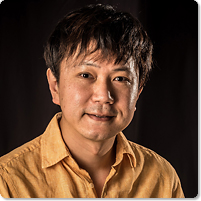
Sung Kiwoong
Born 1974. Playwright, director, leader of the 12th Tongue Theater studio.
While studying Korean Language and Korean Literature at Yonsei University, Sung spent one year studying Japanese on an exchange program with the Korean department of Tokyo University of Foreign Studies in 1999. After returning to Korea he did graduate studies at the Korea National University of Arts’ School of Drama.
In 2006, Sung debuted as a playwright and director with his play Private Third Class. In addition to his activities as a writer and director, Sung was also active in multiple roles as a translator, interpreter, directing assistant and producer in the world of Japanese and Korean theater. Working in collaboration with Japanese director Junnosuke Tada of Tokyo Deadlock, he created the plays Karumegi (2013) and Taifu Kidan (2015). Among his works as a translator are the three-volume collection of selected plays of Oriza Hirata, titled Collected Plays of Oriza Hirata, and he has co-translated and published [Oriza Hirata’s] For Contemporary Colloquial Theater, and published Collected Plays of Yoji Sakate,: The Attic.
In 2011, Sung’s production of Kagakusuru Kokoro – Mori no Oku Hen (The Scientifically Minded – Deep in the Forest Edition) based on the play by Oriza Hirata won the Excellent Drama award of the 4th Korean National Theater Grand Prix; in 2012, he won the Best Director award of the 1st Seoul Theater Grand Prix for a production of Too much love, too many; in 2013, Sung’s play Karumegi won the Best Play, Best Director and Best Visual and Sound Design awards of the 50th Dong A Play Awards; and in 2014, he won the 4th Doosan Artist Award and the Young Artist Award of the Ministry of Culture, Sports and Tourism.
Interviewer: Noriko Kimura, performing arts coordinator
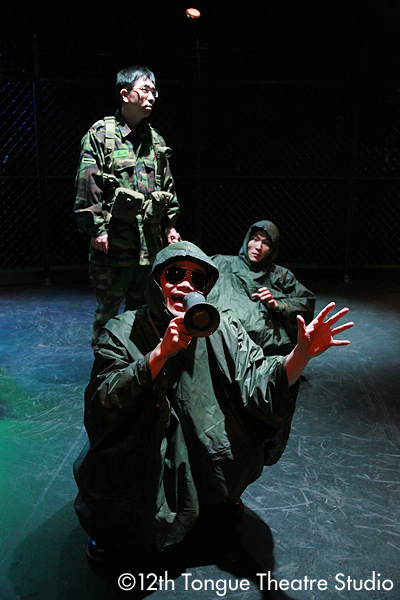
12th Tongue Theater Studio production
Private Third Class
(2006, Yonwoo Theater)
Written and directed by Sung Kiwoong
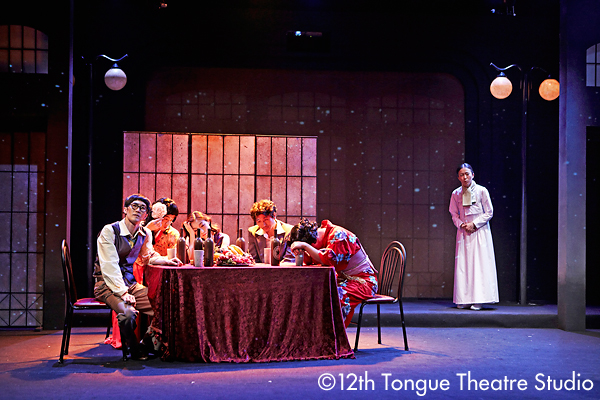
12th Tongue Theater Studio production A Day in the Life of Novelist Mr. Kubo
(2010, Doosan Arts Center Space 111)
Written and directed by Sung Kiwoong
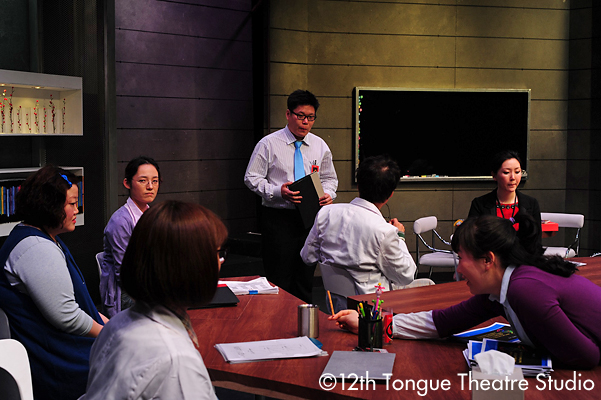
12th Tongue Theater Studio production The Balkan Zoo
(2009, Doosan Arts Center Space 111)
Written by Oriza Hirata, directed by Sung Kiwoong
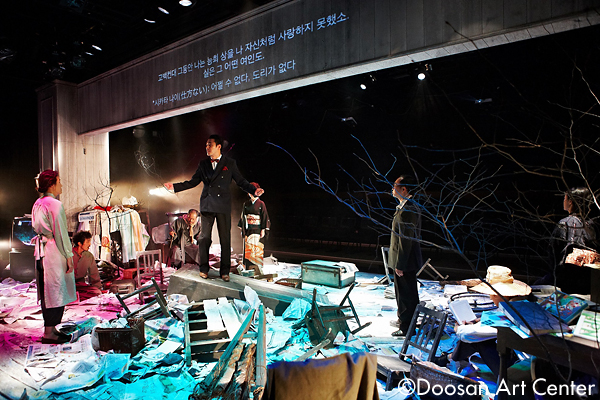
Doosan Arts Centre production of Karumegi
(2013, Doosan Arts Center Space 111)
Written by Sung Kiwoong, directed by Junnosuke Tada
Related Tags

